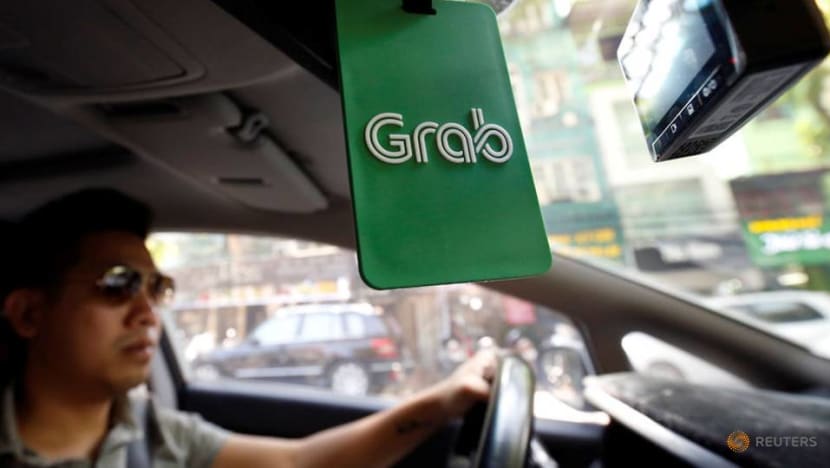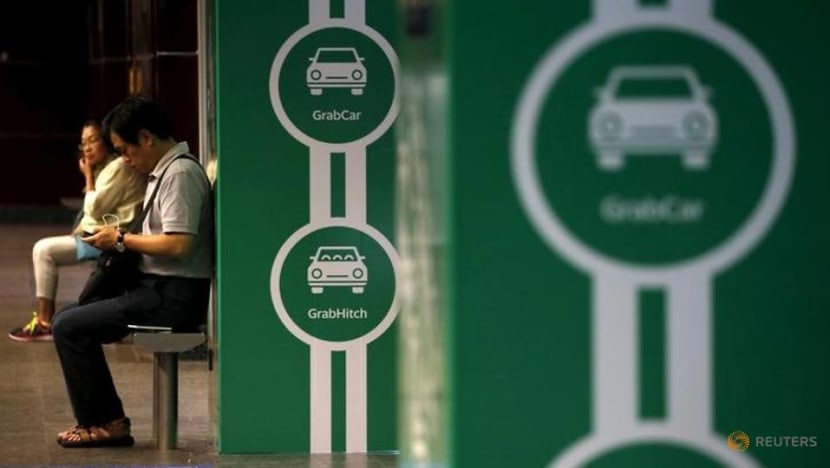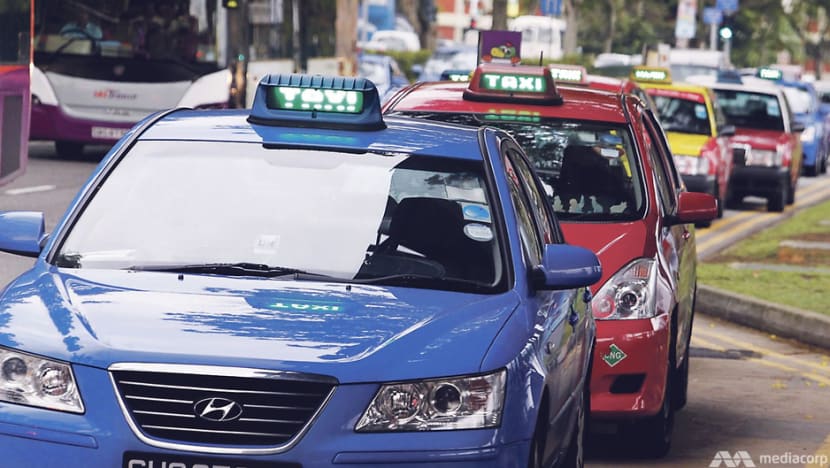commentary Commentary
Commentary: How the new Point-to-Point Transport Industry Bill levels the playing field for ride-hailing operators
The new Point-to-Point Transport Industry Bill will also give drivers better choice over which operator to drive for, say two experts from the National University of Singapore.

A Grab taxi drives on a street in Hanoi, Vietnam on Oct 29, 2018. (Photo: Reuters/Kham)
SINGAPORE: Since the arrival of ride-hailing apps on our smartphones in Singapore less than a decade back, the way we’ve managed to get a ride to bring us from one point to another has vastly changed.
Gone are the days of waiting for a taxi to come by and hoping no one in front of you flags the cab down first.
More private-hire cars have spilled onto the scene as apps like Grab, Go-Jek and at one point, Uber, ignited demand. Although their arrival has been welcomed by commuters and drivers, the future of ride-hailing has sparked fresh concerns about competition, fairness and the protection of the public interest.
In this context, Parliament’s recent passing of the Point-to-Point Passenger Transport Industry Bill will change how taxis and ride-hailing services are regulated in Singapore to the benefit of commuters and drivers.
These regulatory changes will ensure robust competition between operators supplying point-to-point services when they come into effect next year although the changes may not be immediately noticeable to riders.

READ: Commentary: Road safety and the case for regulating private-hire car operators
FIRST IN THE WORLD
The Singapore Government’s approach to licensing is a first in the world to the best of our knowledge. The bill introduces new licensing of operators based on how they match riders and drivers, by street-hailing or ride-hailing.
This is in contrast to treating operators differently based on whether they have historically been labelled taxi operators or ride-hailing platforms, or whether the vehicle type they service are labelled taxis or private hire cars.
The new rules close a vital gap in regulation when it comes to levelling the playing field between street-hail and ride-hailing companies by requiring the latter to obtain a ride-hailing license.
READ: Commentary: Go-Jek and Grab’s two competing visions are knocking heads in Asia
Prior to this bill, the Government only issued taxi operator licenses to traditional taxi companies, allowing their drivers to street-hail and ride-hail, while ride-hailing firms did not need licenses to operate.
Operators that employ the same way of matching riders and drivers will face essentially the same regulation.
Once these rules kick in, a taxi company that also offers a ride-hailing app, such as ComfortDelGro, must apply for an additional ride-hailing license since they have an app-based booking service. Regulators can require compliance with safety and other standards they might set going forward.

TACKLING A LACK OF CONSUMER INFORMATION IN STREET-HAILING
The new rules also recognise the vastly different market failures that can arise for the two different ways riders and drivers are matched.
Under street-hailing, in a completely unregulated market, drivers would be able to take advantage of riders when passengers hop into a street-hailed cab.
Drivers can take a circuitous route or add unexpected surcharges at the end of the trip. This quickly erases the efficiencies from quick matching via street-hailing.
READ: Commentary: Ride-sharing should reduce congestion, not increase it
The Government will use street-hail licenses to ensure that operators price rides transparently and drivers are trustworthy, as it has done with the current taxi operator’s license scheme.
Ride-hailing operators use technology to address some of these problems. When booking a ride, riders get upfront information about the driver, car, and the price of the trip. Operators can screen out unscrupulous drivers based on rider feedback and ratings.
DEALING WITH THE RIDE-HAILING INDUSTRY’S MONOPOLISTIC TENDENCIES
However, ride-hail trips require other forms of regulation, given the industry’s tendencies for domination owing to the “network effects” of ride-hailing services.

Riders prefer a ride-hailing operator with more drivers on the road, compared to waiting to flag a cab since waiting times to get matched bookings are shorter given the higher chance of a driver being nearby.
Likewise, drivers prefer an operator whose app is used by many riders since it increases the chance of a rider being nearby, minimising drivers’ idle time and time spent getting to the next commuter.
READ: Commentary: Shortening the waiting time for your cab with a driver guidance system
Such preferences give operators with larger networks an edge over competitors with smaller networks.
The same is not true for street-hailing operators since riders typically choose whichever taxi they see first. They do not care about how many other drivers are signed up with the same operator.
What this means is that ride-hailing services are more susceptible to monopolisation, raising concerns of market power and barriers to entry.
TACKLING EXCLUSIVITY CLAUSES
One way that a dominant ride-hailing operator can exploit these network effects is by making exclusive deals with drivers or the taxi operators they drive for, disallowing these drivers from operating on other networks.
Indeed, this has been a problem, for example, when Grab previously prohibited drivers from also driving for any rival operator. With existing drivers all tied up under exclusivity clauses, this made it challenging for any new entrant to grow.

In this regard, the Government’s new ride-hailing licenses prohibiting such exclusive contracts ensures contestability in the ride-hailing market and is to be welcomed.
As long as drivers can operate on multiple networks at once, riders can reach these drivers regardless of which app they use. For instance, drivers of ComfortDelGro taxis will then be able to ride-hail for Grab, Gojek and other ride-hailing operators since ComfortDelGro will no longer be able to apply ride-hailing exclusivity to its drivers.
Prohibiting exclusive contracts will lead operators to refocus competition on other dimensions such as price and service levels, to the benefit of riders.
There will be less of a need for price regulation with competition constraining operators’ ability to charge excessive prices.
READ: Commentary: Game of unicorns – as more seek IPOs, is this tech bubble about to burst?
So, it is no surprise that although the Public Transport Council will be given powers to ensure fares are clear and transparent, they have also highlighted their intention to “leave market forces to set appropriate fares”.
LOOK AT HIDDEN EXCLUSIVITY MEASURES
Notwithstanding the successful passage of this bill, regulators cannot let up. They must apply the prohibition on exclusivity widely.
They must also identify de facto exclusive arrangements hidden from plain sight, such as an operator using partnerships with car rental companies or insurance companies to limit drivers from other operators.
Indeed, a dominant operator, facing a ban on exclusive arrangements, may make greater use of loyalty schemes that give incentives for drivers to do most or all of their driving on its platform. Such arrangements need to be carefully monitored to see if they are creating de facto exclusivity, in which case authorities may have to step in.
A LEVEL PLAYING FIELD
With these new regulations in place, commuters could be picked up by a ComfortDelgro taxi when booking a ride on Gojek.
It is also possible that commuters could be picked up by a taxi dispatched by Grab when they hail a cab on the street. This reflects that applying for a street-hail license for Grab will be more attractive, for instance, because of the removal of taxi availability standards by 2020 that street-hail licensed operators previously needed to meet.
Such scenarios will blur the current distinction between traditional taxi operators and ride-hailing platforms, and in our view, that is for the better.
The key to a competitive and efficient point-to-point transport industry is targeted regulations for street-hailing and ride-hailing services, to address the distinct market failures arising in each case, but at the same time, a level playing field across the different types of operators.
That also puts power back in the hands of drivers, so they can choose from a wider range of operators, and are not tied down to any particular operator.
The good news is the approach taken in the recently passed Point-to-Point Passenger Transport Industry Bill does exactly this.
Julian Wright is the Lim Chong Yah Professor at the National University of Singapore’s Department of Economics. Timothy Wong is a lecturer in the same department.

















